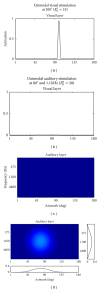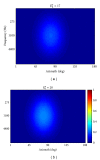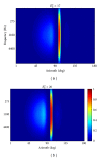A neural network model can explain ventriloquism aftereffect and its generalization across sound frequencies
- PMID: 24228250
- PMCID: PMC3818813
- DOI: 10.1155/2013/475427
A neural network model can explain ventriloquism aftereffect and its generalization across sound frequencies
Abstract
Exposure to synchronous but spatially disparate auditory and visual stimuli produces a perceptual shift of sound location towards the visual stimulus (ventriloquism effect). After adaptation to a ventriloquism situation, enduring sound shift is observed in the absence of the visual stimulus (ventriloquism aftereffect). Experimental studies report opposing results as to aftereffect generalization across sound frequencies varying from aftereffect being confined to the frequency used during adaptation to aftereffect generalizing across some octaves. Here, we present an extension of a model of visual-auditory interaction we previously developed. The new model is able to simulate the ventriloquism effect and, via Hebbian learning rules, the ventriloquism aftereffect and can be used to investigate aftereffect generalization across frequencies. The model includes auditory neurons coding both for the spatial and spectral features of the auditory stimuli and mimicking properties of biological auditory neurons. The model suggests that different extent of aftereffect generalization across frequencies can be obtained by changing the intensity of the auditory stimulus that induces different amounts of activation in the auditory layer. The model provides a coherent theoretical framework to explain the apparently contradictory results found in the literature. Model mechanisms and hypotheses are discussed in relation to neurophysiological and psychophysical data.
Figures











References
-
- Alais D, Newell FN, Mamassian P. Multisensory processing in review: from physiology to behaviour. Seeing and Perceiving. 2010;23(1):3–38. - PubMed
-
- Ernst MO, Bülthoff HH. Merging the senses into a robust percept. Trends in Cognitive Sciences. 2004;8(4):162–169. - PubMed
-
- Stein BE, Meredith MA. The Merging of Senses. The MIT Press; 1993.
-
- Welch RB, Warren DH. Immediate perceptual response to intersensory discrepancy. Psychological Bulletin. 1980;88(3):638–667. - PubMed
-
- Bertelson P, Radeau M. Cross-modal bias and perceptual fusion with auditory-visual spatial discordance. Perception and Psychophysics. 1981;29(6):578–584. - PubMed
MeSH terms
LinkOut - more resources
Full Text Sources
Other Literature Sources

